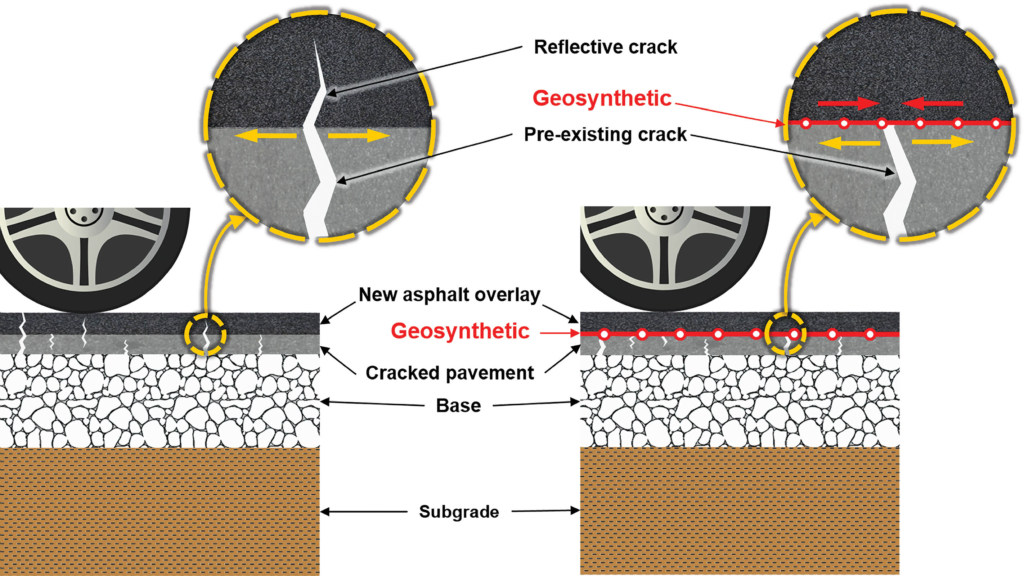Highway construction is an important part of infrastructure. Under complex geological conditions, highway construction faces many challenges. Geosynthetic, as an engineering material, has been widely used in civil engineering, especially highway construction, in recent years. The use of geosynthetic not only improves the efficiency and quality of highway construction, but also reduces construction costs and extends the service life of highways.
Definition and types of geosynthetics
Geosynthetics are materials with specific functions, mainly used in civil engineering, especially in situations where they interact with soil and other basic materials. According to their functions and applications, geosynthetics can be divided into the following categories:
- Geotextiles: used for separation, filtration, drainage, reinforcement, etc. between soil and other materials. Common types of geotextiles include unidirectional, bidirectional and multidirectional fabrics with different strengths and permeability.
- Geomembranes: mainly used for waterproofing, anti-seepage, anti-pollution, etc., widely used in underground structures, dams, landfills and other places.
- Geogrids: A grid structure formed by stretching, which can effectively enhance the tensile strength of the soil and is widely used in the construction of infrastructure such as roads and railways.
The role of Geosynthetics in highway construction
The role of geosynthetic in highway construction is extensive and diverse, and can significantly improve the stability and durability of roadbeds, pavements and related infrastructure.
- Enhance the stability of soil structure: Geosynthetic can effectively enhance the stability of roadbeds and pavements. By laying geotextiles or geogrids in the soil, the shear strength of the soil can be significantly improved to prevent roadbed settlement.
- Prevent soil erosion and settlement: Geosynthetic have good protective functions and can effectively prevent soil erosion caused by natural factors such as rain scouring and weathering, and reduce the settlement of roadbeds.
- Improve the bearing capacity of roadbed: By using geogrids and geotextiles in soft soil foundations, the bearing capacity of the roadbed can be significantly improved, uneven settlement of the road surface can be avoided, and the flatness of the highway can be maintained.
- Permeability management and drainage function: Geosynthetics, especially geomembranes and geonets, can effectively manage water flow, prevent moisture from affecting the roadbed, maintain the stability of the roadbed, and prevent water accumulation from causing damage to the road surface.
- Improve long-term durability and performance of roads: With the help of geosynthetics, the durability of roads is significantly improved, reducing maintenance and repair costs and allowing roads to withstand various loads and weather changes for longer.

Application of geosynthetics in highway subgrade treatment
In highway construction, especially in soft soil foundation and complex terrain, the application of geosynthetics is particularly important.
Soft soil foundation reinforcement and stabilization:
- Soft soil foundation often needs to be reinforced due to its low bearing capacity and large settlement. Geosynthetics such as geogrids and geotextiles can effectively disperse the road load, improve the shear strength of the soil, and prevent the subgrade from settling.
Subgrade settlement control: - The use of geosynthetics to lay appropriate layers in the subgrade can effectively slow down the settlement rate of the subgrade, improve the settlement distribution, and ensure the flatness and stability of the highway.

Construction methods and technologies of geosynthetics in highway construction
Laying geosynthetics:
During construction, geotextiles and geomembranes usually need to be laid according to design requirements to ensure that the lap and overlap lengths of the materials meet the specifications to achieve the best protection effect.
Quality control and standards:
- Quality control is crucial in the construction of geosynthetics. This includes material selection, density and connection methods during laying, and durability testing of materials.
- Common problems and solutions:
- During the construction process, problems such as loose joints and damaged materials of geosynthetics may occur, and timely repair measures need to be taken to ensure the quality of the project.
Case Analysis
By analyzing highway construction cases, we can better understand the actual application effect of geosynthetics.
Typical case analysis:
During the construction of highways in soft soil foundations, mountainous areas or flood-prone areas, the application of geosynthetics effectively improved the project quality and economic benefits.

Conclusion
Geosynthetics play an extremely important role in highway construction. They can not only improve the stability and durability of highways, but also reduce construction costs and improve the ecological environment, with significant economic and environmental benefits. In the future, with the continuous advancement of technology, geosynthetics will play an increasingly important role in infrastructure construction.





